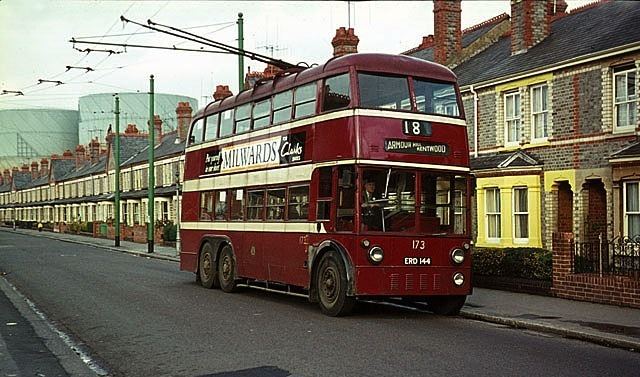Status Closed | Routes 4 | |
 | ||
Open 18 July 1936 (1936-07-18) Close 3 November 1968 (1968-11-03) | ||
The Reading trolleybus system once served the town of Reading in the English county of Berkshire. Opened on 18 July 1936 (1936-07-18), it gradually replaced the Reading tramway network. By the standards of the various now-defunct trolleybus systems in the United Kingdom, the Reading system was a moderately sized one, with a total of four routes, and a maximum fleet of 63 trolleybuses, a size that lasted from 1 December 1950 to 27 March 1952. The system closed on 3 November 1968 (1968-11-03).
Contents
History
The first trolleybus wiring erected was a training loop on Erleigh Road, which opened in early 1936. This loop was never used in public service, and was subsequently dismantled. Public services commenced on 18 July 1936, on a route replacing the tram route from Caversham Road to Whitley Street. In May 1939, the remaining tram routes from Oxford Road to Wokingham Road and London Road were converted to trolleybus operation, with a short extension from Wokingham Road to the Three Tuns, and a much longer extension from the Oxford Road through the centre of Tilehurst to the Bear Inn. The extended main line from the Three Tuns to the Bear, still exists today as Reading Buses route 17, the town's busiest and most frequent route, and the first to be designated a premier route.
During World War II a trolleybus branch was constructed from the Oxford Road to Kentwood Hill, enabling trolleybuses to replace motor buses with a consequential saving in precious oil based fuel. In 1949 the Whitley Street line was extended to Whitley Wood and Northumberland Avenue and a short branch was built to Reading General station. Subsequent short extensions took the system to its full extent, with the Kentwood route running to Armour Hill and the Northumberland Avenue line running to the junction with Whitley Wood Road.
By 1965, most UK trolleybus systems had closed, and the manufacturers of the overhead equipment gave notice that they would cease production. At the same time the trolleybuses came in for some bad publicity in the local press because they cost more to operate compared to motor buses and they were inflexible, even though the trolleybuses were profitable (Reading's motor buses made a loss), faster and less polluting. Reading Corporation decided to abandon the trolleybus system, and the routes were phased out between January 1967 and November 1968.
The UK's first contra-flow bus lane was instigated along Kings Road, when that road was made one-way in the early 1960s. The trolleybuses continued to operate two-way, as it was considered uneconomic to erect wiring on the new inbound route, London Road. The concept of the contra-flow bus lane was proved successful, and adopted in other places for motor buses.
Preservation
Five of the former Reading trolleybuses are now preserved. They are owned by the British Trolleybus Society, which was founded in 1961 as the Reading Transport Society, and are kept at the Trolleybus Museum at Sandtoft.
